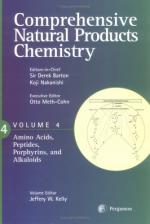|
This section contains 1,472 words (approx. 5 pages at 300 words per page) |

|
Amino acids are the building blocks of proteins and serve many other functions in living organisms. An amino acid is a molecule that contains a terminal acidic carboxyl group (COOH) and a terminal basic amino group (NH2). The approximately 20 amino acids (plus a few derivatives) that have identified as protein constituents are alpha-amino acids in which the -NH2 group is attached to the alpha-carbon next to the -COOH group. Thus, their basic structure is NH2CHRCOOH, where R is a side chain. This side chain, which uniquely characterizes each alpha-amino acid, determines the molecules overall size, shape, chemical reactivity, and charge. There are hundreds of alpha-amino acids, both natural and synthetic.
The amino acids that receive the most attention are the alpha-amino acids that genes are codes for, and that are used to construct proteins. These amino acids include glycine NH2CH2COOH, alanine CH3CH...
|
This section contains 1,472 words (approx. 5 pages at 300 words per page) |

|


